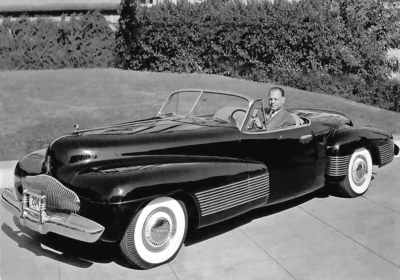BIO: HARLEY EARL-GM KING OF STYLE
BIO: HARLEY EARL - GM KING OF STYLE
By Bob Hagin
Originally published May 7, 1999
Recently I received a phone call from Richard Earl who had gotten my name from the roster of the Society of Automotive Historians. He noted that one of my areas of interest is sports car racing in California in the late '40s and thought I could help him conduct a research program he's doing on his grandfather. "Perhaps you've heard of him," Earl asked. "His name was Harley Earl."
Asking a long-time eclectic auto enthusiast like myself if he recognizes the name Harley Earl is like asking a motion picture historian if he or she recognizes the name Cecil B. DeMille. Both names go back many decades but both impacted their respective industries to the point where their influences are still felt.
In the very early days of the automobile, little thought was given to the esthetic design of the exterior. Horseless carriages were just that - buggies without horses - but as time went by and the automobile evolved, the design of the body changed rapidly. Larger and larger engines found themselves in sheetmetal "boxes" mounted in front of the occupants, while metal half-circle fenders kept the tires from splashing mud on those inside the cabin. Only the very expensive custom-built vehicles were afforded the luxury of having bodies designed with an eye for beauty as well as comfort.
It was into this world that Harley Earl was born in Southern California in 1893, the son of Jacob William Earl whose company, the Earl Carriage Works, made horse-drawn carriages for the well-to-do in Los Angeles. By 1910, the name of the company was altered to the Earl Automobile Works, a necessary change that reflected the times. Earl Automobile Works constructed custom luxury cars for stars of the movie industry, and after short stints at Stanford and USC in 1919, Harley Earl became chief designer for Don Lee Coach & Body Works, a company that had bought his father's automotive operation.
By the 1920's, General Motors was under the direction of Alfred P. Sloan Jr., a visionary businessman who realized that the future expansion and profitability of G.M. lay in its ability to produce new designs each year that would show a significantly change from the previous year's versions. Sloan can also be credited with the concept of providing customers with upscale in-house vehicles that would reflect their growing personal affluence. To fill the gap between its upper-class Buick and its luxury Cadillac, G.M. was in the throws of birthing the LaSalle name but needed "something" to bring the new brand to the attention of the auto-conscious public.
That "something" was Harley Earl, whose Hollywood designs had caught the attention of Lawrence Fisher, general manager of Cadillac, the G.M. division would be the "parent" of the fledgling La Salle. In 1926, Earl was invited to Detroit as a consultant to design the new car and the result was an early "first" for the young coach builder: the 1927 LaSalle was the first assembly-line auto to be designed by a "stylist" rather than by engineers. By mid-1927, Earl was hired by Sloan to head up G.M.'s new Art & Color Section, another "first" for Earl. Never before had a major car manufacturer set up a separate section for the development of the "glamour" aspect in the production of its products.
In his biography "My Years With General Motors," Alfred Sloan revealed that "...the first car to be styled completely by the Art & Color Section was a tremendous flop from the public standpoint." The 1929 Buick was immediately dubbed "the pregnant Buick" because of an ungainly bulge that developed just below its beltline when Earl's original graceful lines had been slightly altered by factory engineers to facilitate easier production. In an interview 25 years later, Earl stated that he "..roared like a Ventura (Calif.) sea lion.." when he saw the modification but it was too late for an immediate fix, according to Sloan. It was one of the few styling "mistakes" Earl let slip through during his tenure at General Motors.
From that time on, Earl was on a mercurial rise that saw him and his crew of young designers produce hit after hit and change the course and structure of the auto world. Art & Color Section became a full-fledged G.M. department in 1930 and ten years later it developed into the G.M. Styling Staff with Earl as its initial vice president, the first time a stylist had ever risen to that type of lofty level. Among other firsts, Earl produced the first "concept car", the Buick "Y-Job" of 1938, instigated the first use of two-tone paint on production cars, developed the first curved "wrap-around" glass for windshields in production cars and the originated the first use of "fishtail" rear fenders. He also pioneered the hiring of women in the auto industry above the level of secretarial and clerical positions.
But perhaps his most lasting impact on the American auto scene was his "fathering" of the first Corvette in 1953 after watching the Watkins Glen (NY) amateur sports car races in 1951.
In retrospect, I could have made an elaborate response to Richard Earl's question wondering if I'd heard of his grandfather. As it was, the only answer I could think of was that Harley Earl was "... the General Motors guy." Of all the towering figures that have come out of G.M., Earl's name is the one that comes to my mind first.



